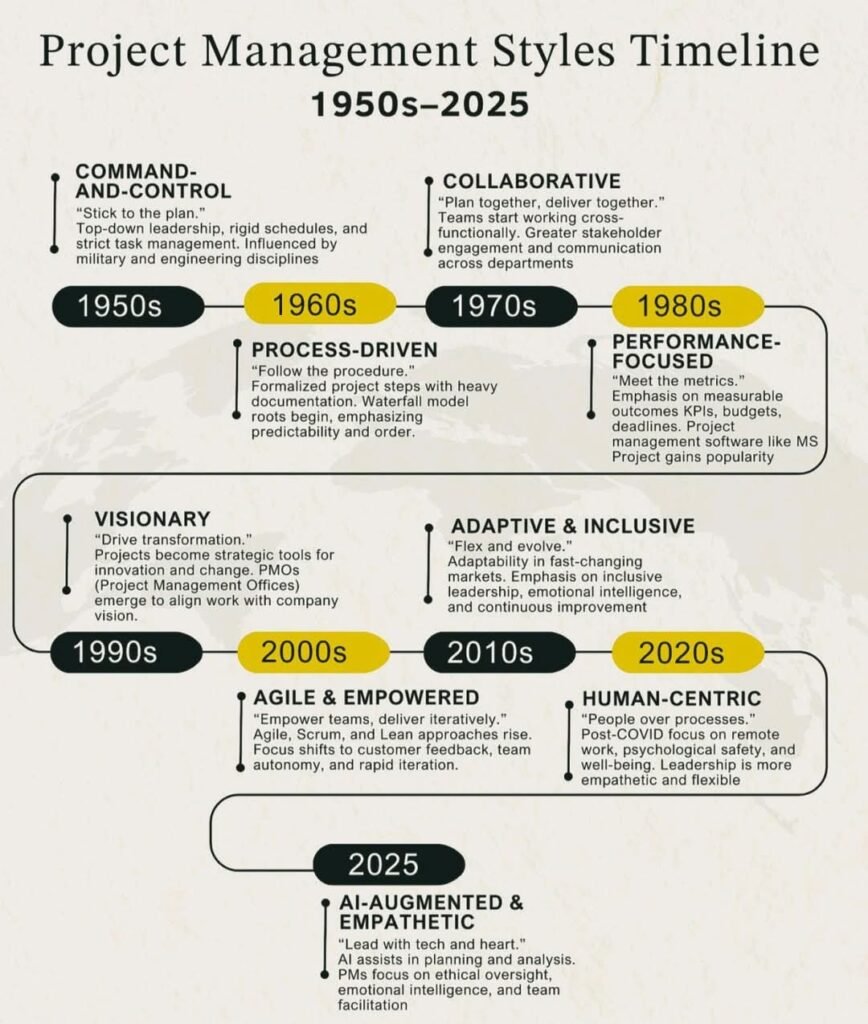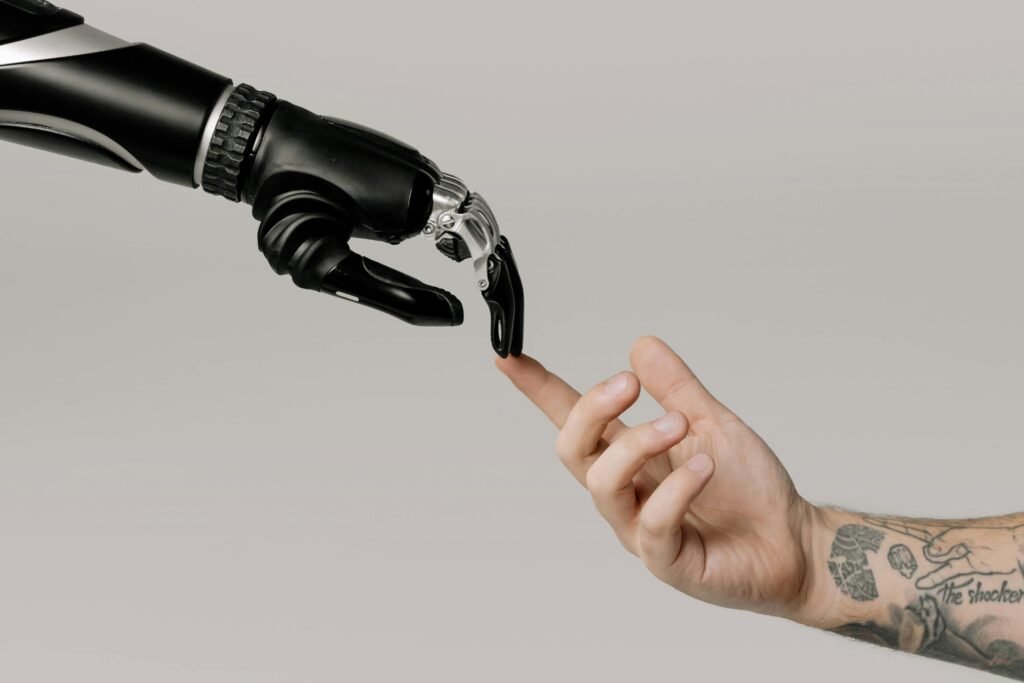
Picture a leader’s notebook, each page a lesson from decades of project management, starting in the 1950s and stretching to 2025. As someone who’s led projects through these eras, I’ve filled my notebook with nine styles—Command-and-Control, Collaborative, Process-Driven, Performance-Focused, Visionary, Adaptive & Inclusive, Agile & Empowered, Human-Centric, and AI-Augmented & Empathic. Each style taught me something new about leading teams and delivering results. Let’s flip through these pages to see how they evolved and what they mean for you today.
1. Command-and-Control (1950s): The Strict Rulebook
Back in the 1950s, projects were run like a military drill—top-down orders, strict schedules, and no room for mistakes. It worked for big builds, like bridges, but felt stiff. I learned it’s great for structure but tough when changes pop up.
To stay flexible, check out Mastering Adaptability: 5 Strategies on How to Best Overcome Uncertainty. PMI’s Project Management Basics explains its origins.
Key Lesson: Structure keeps things on track, but flexibility keeps them moving forward.

2. Collaborative (1970s): The Team Huddle
By the 1970s, teams started working together more, involving everyone in planning and decisions. It brought fresh ideas but could get messy if communication faltered. I found it builds stronger teams when trust is there.
Learn how in How to Build Trust: 5 Practical Steps for New Leaders. Harvard Business Review dives into its teamwork benefits.
Key Lesson: Working together sparks creativity, but clear communication keeps it flowing.

3. Process-Driven (1960s): The Step-by-Step Plan
In the 1960s, the focus was on clear steps, like the Waterfall method—plan everything, then build, then test. It kept things organized but didn’t handle surprises well. I learned to streamline plans to save time.
See how in Why Automation Matters: 5 Strategies to Gain an Edge. Forbes covers its history.
Key Lesson: A good plan sets the stage, but room for change keeps the show going.

4. Performance-Focused (1980s): The Numbers Game
The 1980s brought a focus on results—tracking budgets, deadlines, and goals with tools like MS Project. It pushed efficiency but sometimes ignored team morale. I learned to balance numbers with care for my team.
Explore this balance in The EQ Edge: Emotional Intelligence in Leadership for 2025. McKinsey & Company discusses its impact.
Key Lesson: Goals drive success, but caring for your team drives loyalty.

5. Visionary (1990s): The Big Picture Guide
In the 1990s, projects started aligning with the company’s big goals, thanks to Project Management Offices (PMOs). It gave projects purpose, but I noticed misaligned visions caused delays.
To lead with clarity, try Vision in Action: How to Translate Big Ideas into Decisions. MIT Sloan Management Review explains its strategic role.
Key Lesson: A shared vision guides the team, but alignment keeps everyone on the same path.

6. Adaptive & Inclusive (2000s): The Flexible Team
The 2000s focused on adapting to change and including everyone’s ideas, using emotional intelligence to lead. I found it made teams stronger, though it took effort to balance all voices.
To handle change well, read Mastering Change Management: A Practical Guide for Leaders.
Key Lesson: Listening to everyone builds a stronger team, especially in changing times.

7. Agile & Empowered (2010s): The Fast-Moving Squad
The 2010s introduced Agile and Scrum, letting teams work in short bursts and make decisions on their own. It sped things up, but I noticed it could tire teams out.
To avoid burnout, delegate smartly with Stop Burnouts: 5 Strategies on How to Delegate Effectively. Agile Alliance shares its core ideas.
Key Lesson: Speed and freedom boost results, but pacing keeps the team strong.

8. Human-Centric (2020s): The People-First Approach
After COVID, the 2020s put people first, focusing on well-being and safety, with leaders showing more empathy. I saw happier teams deliver better work when they felt supported.
Build this skill with How to Build Emotional Intelligence as a Leader.
Key Lesson: Putting people first creates a team that thrives, even in tough times.

9. AI-Augmented & Empathic (2025): The Smart and Caring Leader
Today, in 2025, AI helps plan and predict, while leaders stay empathetic and ethical. I’ve used AI to spot risks early, but it’s the human touch that keeps teams motivated.
To use AI well, check out How to Use AI for Smarter Project Management in 2025.
Key Lesson: AI makes work smarter, but empathy makes it meaningful.

What are we heading to?
This leader’s notebook, filled with nine project management styles—Command-and-Control, Collaborative, Process-Driven, Performance-Focused, Visionary, Adaptive & Inclusive, Agile & Empowered, Human-Centric, and AI-Augmented & Empathic—shows how far we’ve come. We’ve moved from rigid, top-down rules in the 1950s to a balanced mix of technology and empathy in 2025. Each style reflects the needs of its time, teaching us to adapt, collaborate, and care for our teams while embracing new tools.
Looking ahead, project management is set to evolve even further. AI will take on bigger roles with hyper-automation, handling repetitive tasks like scheduling or risk analysis, freeing leaders to focus on strategy and creativity. Ethical AI will become a priority, ensuring fairness and transparency in decisions. We’ll also see deeper human-AI collaboration, where tools not only predict outcomes but also suggest ways to boost team morale or solve conflicts. The future is about blending the best of tech and humanity—smarter systems paired with a stronger focus on well-being and inclusivity.
Each style in this notebook offers a lesson to help you lead better today. Pick the ones that fit your team, whether it’s the structure of Command-and-Control or the empathy of Human-Centric, and start applying them. For more leadership tips, visit Leadership Development. As we head into this exciting future, what will you focus on—mastering AI tools or strengthening your team’s human connection?


